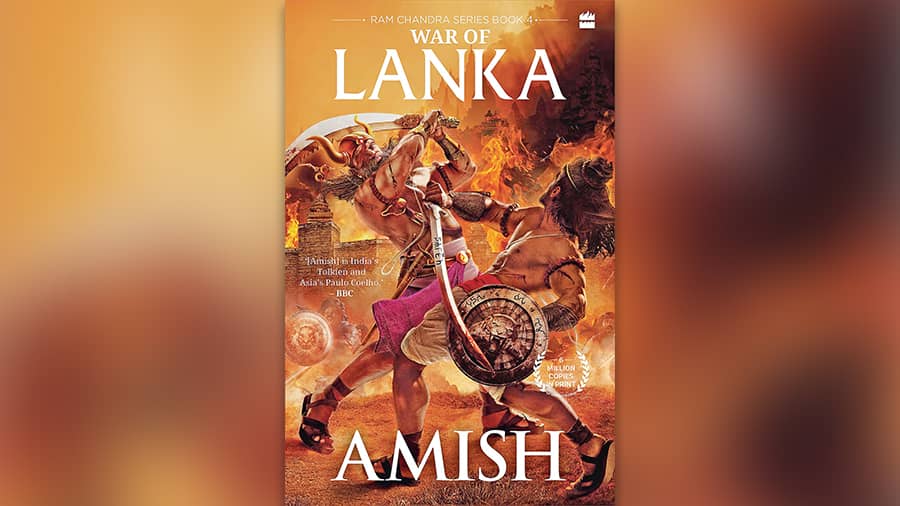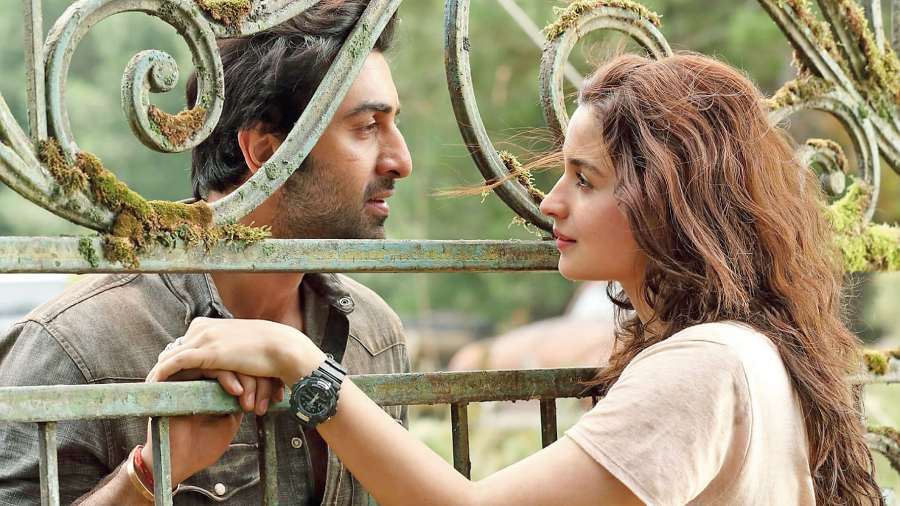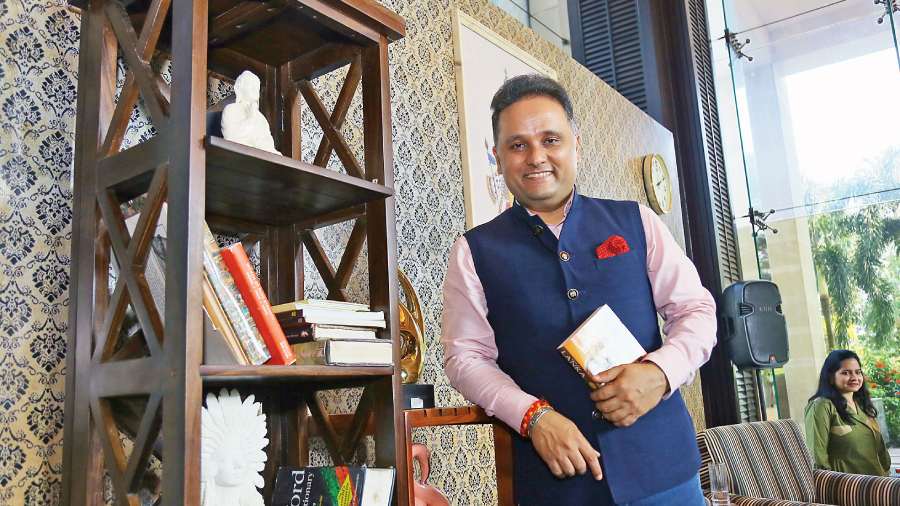Amish Tripathi has to be a man in a hurry. On a whirlwind tour of the nation over a fortnight to promote his latest title in the Ramchandra series, War of Lanka, he is in Kolkata for a day where he has five back-to-back events lined up. Yet, get him talking and he makes you feel as if it is a leisurely conversation happening at home. His management course at IIM-Kolkata must have included time management skills as well, one wonders. Over to the amiable author to share his thoughts on his passion project and his upcoming screen ventures. Excerpts.
You had to shift to a new publisher for War of Lanka.
Yes. I was with Westland Books till it shut down. We started negotiating with various publishers and Harper Collins came up with the best deal.
They have also taken your backlist.
Yes. My books sell together. You notice that when a new book comes out, all the previous books enter the Top 10. When (Legend of) Suheldev launched, seven of my books were in the Top 10. Many of my books are interconnected; so it makes sense for one publisher to have the entire library. The book covers will not change. That was a wise decision.

What goes into the War of Lanka?
My three earlier books in the Ramchandra series, as you are aware, were multi-linear narratives, with three parallel storylines ending at the same point. The first book, Ram Scion of Ikshvaku, is from the birth of Lord Ram to the kidnapping of Goddess Sita, the second, Sita Warrior of Mithila, is from her birth to her kidnapping while the third, Ravan Enemy of Aryavarta, is from his birth to Sita’s kidnapping. War of Lanka is now a common narrative in which all the three parallel narratives merge. It covers from the kidnapping of Goddess Sita to the end of the war, the death of Ravan and the return of the royal couple to Ayodhya. The structure gave readers a good understanding of the three characters who drive The Ramayana forward. The point that brought them together was the kidnapping. Now you’ll have the common story. War of Lanka ends where most Indians in the modern day think The Ramayana ends.
The cover has two warriors of equal physical stature locked in combat. Did you want to show them as equals?
Lord Ram and Ravan represent the best and the worst in us. Ravan was also exceptionally talented. He defeated many of the devas (Gods) because he was a great warrior. He was also a brilliant scholar of the Vedas, a superb musician. Despite all his talent, he was led on the wrong path by his ego and anger and failure to control his desires. He abused women like the apsara Rambha. What happens to Ravan is a warning for us.
Annals on war are written in favour of the victor. If the results went the other way, do you think we would have had a Ravanayana in place of a Ramayana?
The stories we celebrate in the dharmik way are the ones where the positive triumphs over the negative. If you read The Mahabharata, it shows the strengths of the Kauravas too. But if the Kauravas had defeated the Pandavas, would the story have been celebrated? There have been many battles in India. Which are the battles we celebrate and try to learn from? Ravan himself won many battles. In fact, his first and last defeat was at the hands of Lord Ram. But those earlier stories are not celebrated. These are spiritual stories, not a history book. We will celebrate a story only when the right lesson can be drawn from it. It is erroneous to consider dharma to be religion. Dharma for us is a way of life which is noble or balanced or that which sustains. So the Gods you worship will not make you dharmik or adharmik. Lord Ram and Ravan both worship Lord Shiva. But one is dharmik, the other is adharmik. Your deeds decide whether you are on the path of dharma or adharma.
You had planned the series over a span of five books. When are you planning the fifth?
That will take some time. I might do another book in between. The fifth book will be on Uttarkaand but you’ll have a sense of conclusion in this one itself. It is in a way an ending. The fifth book will be an add-on. This will provide viram (pause), the fifth book will be a purnaviram (complete pause).
The marketing of this book has been interesting in the way teasers have been brought out asking questions like “what happens to Ravan’s eye” or “what happens to Ravan’s pendant”. How involved are you with such moves?
I am very closely involved, especially in the designing of the covers. I like to leave clues in the cover for the hardcore readers. I rarely explain those. In fact, this is the first time that we ourselves are talking about these clues which are there to be decoded. There are social media groups like The Immortals Facebook group, which are managed by the readers themselves. Hardcore readers decode and discuss the clues amongst themselves. I visit the page at times to read the fan theories. Some readers go deeper into the philosophy or the hidden messages that are on the covers of all books of mine. If you notice the covers, there are things written in Brahmi script, something from the Upanishads or Buddhist texts… I love it when readers decode those.
Recently you shared a post of a fan who has created your face with Rubik’s cube.
(Smiles) Yeah, it was very sweet!

Ranbir Kapoor and Alia Bhatt in a scene from Brahmastra Part One: Shiva. The new generation may want to consume mythology through books and films, Amish says
What kind of messages are posted on these fan pages?
It’s a community. Some readers are artists themselves. They create pictures or music and share it. The Ramchandra series and the Shiva Trilogy are actually linked to each other. I have left clues in The Oath of the Vayuputras and The Immortals of Meluha which are tied up now in the new series, in The War of Lanka or Ram Scion of Ikshvaku. Some people make those connections in those stories. Some make tattoos out of the cover illustrations. I use some philosophy from the Upanishads or the various Gitas. Some like to go deeper into the philosophy.
You mentioned various Gitas.
Yes. They explore different philosophies. We are more familiar with The Bhagavad Gita, which is a conversation between Lord Krishna and Lord Arjun. But there is also The Ashtavakra Gita which is a conversation between King Janak and Lord Ashtavakra. It explores subjects like what is life and what is reality. The Bhagavad Gita is built around the purpose of karma.
Coming to the various Ramayanas, in one of your clips you have mentioned the Adbhut Ramayana where Sita is said to have killed Ravan.
There are three versions of The Ramayana that are credited to Valmiki — Valmiki Ramayana, Anand Ramayana and the Adbhut Ramayana. In the Adbhut Ramayana, there are two Ravans — one is younger and the other is older and more powerful, Sahastravadan Ravan. The elder Ravan was killed by Sita Ma who took the form of Ma Kali.
That’s very interesting for readers in Kolkata as Kali is revered here and according to a theory, lends her name to the city.
In fact, the Bengali version of The Ramayana by Krittivas is among the first devotional versions of The Ramayana where Lord Ram is clearly a God. Valmikiji sees him as human, other than in the Baalkaand and the Uttarkaand, which form the beginning and the end of the epic. Remember the boon that Ravan had asked for — that he could not be killed by deva, asura or gandharva. He did not ask to be protected against men as he thought men would be powerless against him. So Lord Vishnu had to take on a human avatar to kill him. But the devotional versions, like Ram Charit Manas or Kamba Ramayana or Krittivas Ramayana treat him otherwise.
Which version have you been following?
I have followed various versions and also used my own interpretations. For example, at the beginning of Ram Scion of Ikshvaku, I show a war between Lord Dasarath and Ravan close to the sea. That is inspired by Anand Ramayana in which such a battle between the two is mentioned.
You also give a different explanation for why Ram goes on vanvas — to do a penance — and not due to stepmother Kaikeyi’s conspiracy.
Yes. That is my theory that Kaikeyi Ma might have pushed it but she was not the primary driver. Kaikeyi Ma was very fond of Ram, so why should she do this (conspire to expulse Ram from Ayodhya)? Again all four brothers were very close in every version of The Ramayana. I have always wondered why only Lord Laxman went? Why did Bharat and Shatrughan not go along to help them in the battle for Goddess Sita? It would make logical sense. In my War of Lanka, all four brothers went to war. Of course, I cannot lay claim to what the truth is. It is my interpretation.
Even in those days of little or no communication, you think they would have known about the war down south?
It was known that Hanumanji had gone to the Himalayas to get Sanjeevani buti and other herbs that were needed. In one version of The Ramayana, it is said Lord Bharat saw him flying overhead and understood what he was going for. In that case, he would have rushed immediately. That’s what I have assumed.
Do you plan to write an epilogue, where you explain which strands you took from where?
Yes, I plan to do that.
You spoke of Ram being seen as human by Valmiki and as divine by later-day poets like Krittivas and Tulsidas. When you write, which space does he occupy?
In India, we are comfortable with multiple truths. While, as an individual, I have no doubt in my mind that he is God — that is why I always refer to him as Lord Ram —in my books I am closer to the way Valmiki saw it. He is still an avatar of Vishnu but he is human.
So you would not dither to write about his human shortcomings also, like in the Uttarkaand narrative?
Wait for my fifth book! (Smiles) Does Lord Ram go through challenges in my books? Does he go through sufferings? Does he face grief? Yes, he does. That’s what even Valmiki Ramayana says.
Did you get a chance to watch the film Brahmastra?
Yes, I did watch it in London. Ranbir Kapoor has acted brilliantly. The special effects were fantastic. It was very nice to see a movie of that scale doing well. I liked it that they had shot in Kashi. My father’s family is from Kashi, so my roots are there.
Books on Indian mythology are hot picks in bookstores. Are you happy that Bollywood is also getting into this space?
I always believed that the demand was there. Many people keep saying that our younger generation is Westernised and not interested in our culture. I don’t think that is true. We are the only pre-Bronze Age culture that is still surviving. The reason for that is in every age, our younger generation has been interested in our culture. If they were not, then our culture would have died. But they want to hear those stories through their preferred medium, their own prism. There is nothing wrong in that. I am 47. Our generation consumed The Ramayana and The Mahabharata through Amar Chitra Katha and Doordarshan serials. I was different as my family was deep into this tradition and I heard The Ramayana the traditional way. The new generation may consume it through books and movies. Sadly, even though the demand was there, the supply was not there on screen. Now the supply is coming up. I am looking forward to the next instalments of the series.
The last time we spoke, you had said that the script for a film on Legend of Suheldev was ready. What is the status now?
We are looking for a writer and director. The studio has been finalised as Viacom.
What about the other film adaptation you had announced, the Shiva trilogy, with Roy Price, Sekhar Kapur and Suparn S. Varma?
The script is being written. I am delighted that someone of the stature of Sekhar Kapur is helming it. He spends his time now shuttling between London, Dubai and Bombay.
With two film projects in the works, are you keeping an eye on the #boycottbollywood trend?
I am. The Hindi film industry is passing through a phase when a lot of rethinking has to be done. I don’t know if there is a disconnect between the audience and the kinds of stories being told or whether audience tastes have changed. It’s not that movies aren’t working. South Indian films like RRR, K.G.F. and Baahubali made tonnes of money. The Kashmir Files was made on a small budget and made some Rs 300 crore. It did not follow the traditional Bollywood formula at all. There were no songs. In fact, it was a very depressing film that left you shaken. Yet it did well. We are all old enough to remember the late 80s and early 90s. The industry had gone through a similar crisis then. Almost every film was flopping, new technology had come in the form of VHS. Ironically, even then the south Indian-inspired films used to do well. Jeetendra used to spend most of his time in Chennai. I think this time too the Hindi film industry will find ways to reconnect with the audience.

Dona Ganguly, who performed at the Amish-helmed Nehru Centre, London, earlier in the year, welcomes him to a programme at Hyatt Regency on Friday
You hosted an eminent kolkatan at the Nehru Centre in London earlier this year — Dona Ganguly.
Oh yes! We had an event with Dona Gangulyji for Holi in London and we hosted her once again later. Both were among our most successful programmes ever. There were crowds spilling over. She had got her dancers from India. It was wonderful.
How do you keep so many irons in the fire — your Nehru Centre job, your books, you are now presenting shows on Discovery+?
I am a workaholic fortunately! (laughs)
Pictures: Koushik Saha
